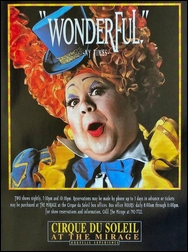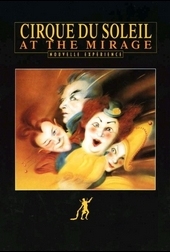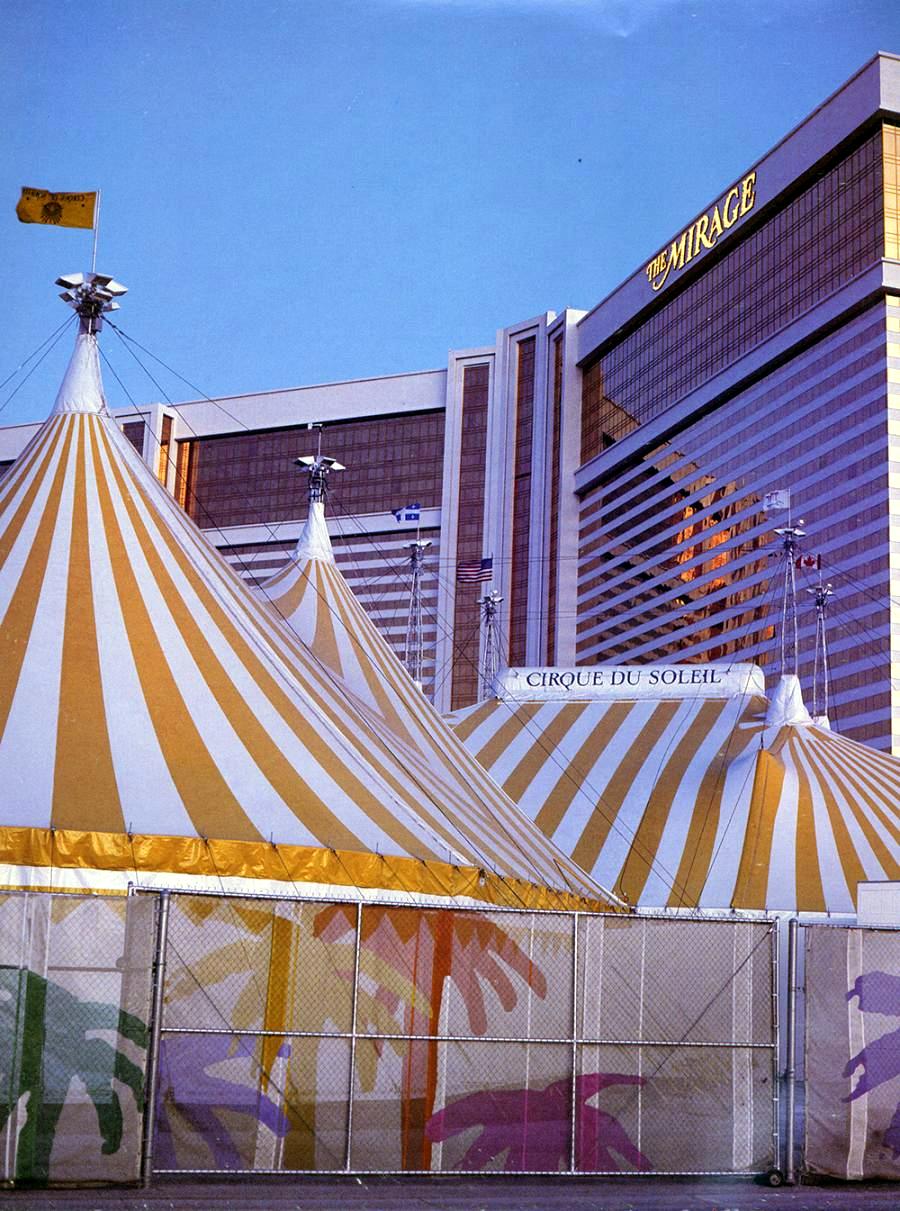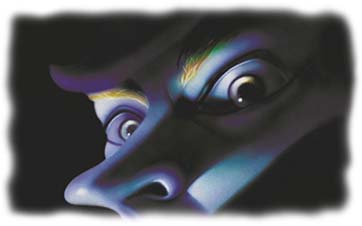

![]()
1980s
1982 · 19831984 · 1985
1986 · 1987
1988 · 1989
1990s
1990 · 19911992 · 1993
1994 · 1995
1996 · 1997
1998 · 1999
2000s
2000 · 20012002 · 2003
2004 · 2005
2006 · 2007
2008 · 2009
2010s
2010 · 20112012 · 2013
2014 · 2015
2016 · 2017
2018 · 2019
2020s
2020 · 20212022 · 2023
2024

PLANTING A FLOWER IN THE DESERT Cirque du Soleil did not start out as a company that was comfortable staying in one place for long. As self-proclaimed "Merchants of Happiness", it was harder to "follow the sun" and bring joy to the masses if you're standing still waiting for them to come to you. And the nascent Cirque was not one to stand still. The most amazing aspect in the amazing growth of Cirque du Soleil is that it began less than a decade ago as the brainchild of a group of long-haired street performers, stilt-walkers and fire-eaters who had the crazy idea that they wanted to start a circus of their own. Now, these graying, balding but still youngish entrepreneurs have become proprietors of an operation that is spreading its engagements, and its influence, on a global scale. Cirque du Soleil was founded in 1984, with a $1.7-million budget, to tour Quebec in celebration of the 450th anniversary of the arrival in Canada of explorer Jacques Cartier. Its roots were in street theater - specifically a group called Club des Talons Hauts - and the circus they presented was unlike anything seen before. There were no animals and no rings. The Cirque du Soleil attracted critical acclaim with its reinvention of the circus as a postmodern combination of derring-do and European-flavoured vaudeville. In the next couple of years, the company found a new audience in English Canada, first in Vancouver and then in Toronto, for its production Le Magie Continue. And then, on a 1987 U.S. tour, Cirque du Soleil went to Los Angeles and dazzled Hollywood's movers and shakers. The film and television offers poured in but they were kept at bay as the Cirque worked to consolidate its gains and mount a second production, Nouvelle Experience. "We did flirt with the devil," Laliberte said, "but the money didn't take over." But even as it put the brakes on and kept the deal-makers at arm's length, Cirque du Soleil continued to grow. The Cirque today is a $35-million operation. Last year there were troupes performing in Japan and Switzerland, but that's just the tip of the Cirque juggernaut. The highest profile in this enlarging empire belongs, of course, to the newest edition of the Cirque productions - Saltimbanco, which is now touring the United States. In its first seven years, the Cirque performed before a total of 3 million customers. This year alone, it will entertain more than 2.5 million people. Many of those in Las Vegas, where it would plant a proverbial flower in the desert that would bloom there for decades to come... A NOUVELLE MIRAGE After conquering English-speaking Canada and later the United States, some within the company considered Las Vegas as a possible place to set up the big top, but an offer to reside permanently in the desert was just a pipe dream, until the Caesars Palace organization approached Cirque to mount a show there. By the dawn of the 1990s, Las Vegas was looking to reposition itself as a family-friendly destination, and Cirque du Soleil's brand of entertainment seemed to fit that bill: they were modern, fresh, and something that could excite every member of the family. But negotiations with Ceasers proved difficult, and the months-long talks ended abruptly. A few hours before the deal was sealed - at the point of signing - Caesars management walked away. According to Jean David, Cirque du Soleil's Marketing and Communications VP, the negotiations had been the talk of the town, so when the word out got that the Cirque was no longer under the yoke of the Roman Empire, the phones began to ring. Steve Wynn, who headed the Mirage Group, called to say that he was interested. A meeting was held in Toronto where Nouvelle Expèrience was playing and by intermission, Wynn saw all he needed to see. After a hand-shake deal, the two companies were in business.
Skepticism followed. The contrast between the Cirque's high-concept circus art and the glitzy artlessness of the desert city was obvious. But Cirque du Soleil believed it to be a natural union. "There is no contradiction," Guy Laliberte said. "I believe in marriages of money and art. People say you have to be in pain and suffering for art but I don't believe that." Still, Las Vegas appeared, on the surface, to be something of a break from its tradition. The Cirque specialized in a rather restrained, cerebral exuberance while garish Las Vegas believes wholeheartedly that too much is not enough. "We're still the same but Las Vegas is changing," David said. The decision to set up a permanent base in the United States was a major step forward and highlighted its profound evolution from a group of street performers almost wholly dependent on government grants to a profitable worldwide concern with hundreds of employees. Company president Daniel Gauthier said he did not believe that settling into Las Vegas would compromise the Canadian troupe's art. On the contrary, he said, a base will allow the troupe to escape the logistical - and financial - burden of touring. Having an anchor will allow the 43 people in the Las Vegas revue to refine their presentations and develop artistically, he said.
But first, Wynn and Cirque would test the waters...
AFFAIRES MONDIALES Meanwhile, as the new wave music that's become associated with Cirque caught the ear of more and more customers, Cirque du Soleil signed with BMG Musique Quebec covering the international release of all recordings of music used in its shows. Cirque du Soleil president Daniel Gauthier said the circus has been recording and selling its music since 1987, but the marketing was carried out mostly under the big top. He said the Cirque had been actively looking for a distribution partner for a a couple of years before the deal with BMG was struck.
Rene Dupere, who has composed and arranged all of the Cirque's music, was all smiles - with good reason. "I must say I'm the great winner in this," he said, explaining that while BMG and Cirque du Soleil now have to share the spoils, his percentage of the profits remains fixed. "Finally, it's paying off." Quick to pick up on the tie-in possibilities present in the distinctive designs and colors of the Cirque's scenic and costume displays, the producers also marketed a full line of T-shirts, sweat shirts, posters, balloons, dolls, umbrellas, tote bags, coffee mugs, watches, baseball caps, key chains, lapel pins, childrens' pajamas, jigsaw puzzles and boxer shorts - available on the site or by mail order. Little wonder that in addition to such artistic prizes as a 1993 Obie Award honoring outstanding achievement in Off-Broadway or Off-Off-Broadway work in New York, the Cirque also won the 1992 "business of the year" category for small and medium businesses, in a competition organized annually by the Chamber of Commerce of the province of Quebec. Despite their expansion into a global business, the managers of Cirque du Soleil keep their productions fresh and changing. "We're not trying to do the (producer Cameron) Mackintosh trip (keeping a big show running indefinitely in dozens of productions around the globe)," says Gilles Ste-Croix, the Cirque's veteran directeur de la creation. "Our success rests on fragile things; the maximum run for any of our shows is four years, which gives the artists a certain job security but doesn't keep them tied up forever. We try to treat our people well, but it's very hard to keep a show alive and challenging and not let down the quality over a long period." The maximum first-run tour for a Cirque production is now two years, beginning in Montreal, and then touring to large cities in the United States and Canada for the rest of the run. While one show is making the grand tour, another show is being developed in workshops and think tanks at home. By the time Saltimbanco ends its travels this year, for instance, the new Cirque edition will be in preparation to premiere in April 1994. And once the intial two-year tour is over, there is now a possibility for further travel abroad, such as last year's Japan engagement. By year's end Saltimbanco would complete it's 19-month North American tour of a dozen cities and receive resounding ovations from 1.4 million (1,416,359 to be exact) spectators. The beat goes on! 
 |


![[Back]](../images/arrow.gif)





 Turned out, it was! Attendance was about 75% of capacity, "which is good," said
Gilles Ste-Croix, "for a show that was new in Vegas.". And so, on Christmas Day 1993,
Turned out, it was! Attendance was about 75% of capacity, "which is good," said
Gilles Ste-Croix, "for a show that was new in Vegas.". And so, on Christmas Day 1993,





